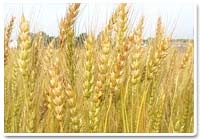
Company Information
Ask for more detail from the seller
Contact SupplierRanked next to maize in terms of consumption, wheat has been playing an important role in leveraging the agrarian scenario of India. The annual production of wheat in India stands at 65-75 million tonnes, thereby making India its second largest producer in the world after China. People in India consume 70-72 million tonnes of wheat on an average. In India, it is commonly known as ‘atta’ and is eaten mostly in the form of rotis, chapatis, etc. There are about 200 flour mills operating in India having a capacity to produce about 15 million tons of wheat.
Definition of Wheat
Wheat is defined as a cultivated grass which is grown primarily for its nutritional grains. It grows anywhere between 2 and 4 feet. The scientific name of wheat is ‘Gramineae’ and belong to the genus ‘Triticum’. There are a wide variety of wheat that can grow in different climatic conditions, whether it’s cold, hot or dry. It is an annual crop that grows once a year, and thus, at the end of each year, the fields must be plowed and prepared to enable the grass to grow. It can be planted to some extent as a forage crop for the livestock, whereas the straw of the wheat can be used to make roof thatching or as fodder for animals.
Types of Wheat
A wide variety of wheat is grown in today’s times. However, the three principal types of wheat that are produced in India comprise of:
History of Wheat
Wheat is one of the oldest forms of crop to be cultivated, and is believed to have been grown in around 10,000 BC. It was first cultivated in Southwest Asia, in an area known as the Fertile Crescent. Even in the Mediterranean region, around the same time, wheat was considered to be a very important crop for cultivation. Wheat played a major role in the Roman empire, so much so that it was often referred to as the ‘Wheat Empire’.
During the Neolithic period, the production of wheat spread to India, Ethiopia, Great Britain, Spain and many other part of the world. By the 18th century, the use of seed drills replaced the practice of manual sowing and by the 20th century, many new forms of cultivation like fertilizers, threshing machines, etc. increased the yield of wheat. Today, new varieties of wheat are being developed throughout the world for better nutritional as well as commercial value.
Process of Wheat MillingWheat should be processed before it can be consumed in the form of a food product, since the insects and germs present it can cause serious health repercussions. Following is a detailed description of how the wheat is processed in a flour mill:
Following are the various stages through which the wheat plant goes, before it is sent to the mills for processing :
Wheat bring with itself loads of health benefits that can be discussed as follows:

